|
Day to Day Working in the Mill Street Goods Depot
By Bev Parker
Wolverhampton High Level railway station was built
as part of a joint venture between the Shrewsbury &
Birmingham Railway, and the London & North Western
Railway. The station was originally called
Wolverhampton General Station, and later renamed
'Queen Street' Station in 1853. The station
buildings were designed by Edward Banks, the
Shrewsbury & Birmingham Railway's architect.
The site also included a purpose-built goods
station, that was jointly owned by the two
companies, and presumably designed by Edward Banks.
It became known as Mill Street Depot, and had
warehouses and canal basins. The railway to
Birmingham, known as the Stour Valley Line, opened
on 24th June, 1852 in the middle of a dispute
between the two railway companies.
After the dispute, the Stour Valley Line was
operated solely by the London and North Western
Railway, who purchased the Shrewsbury and
Birmingham Railway's half share in the goods depot in
September, 1859.
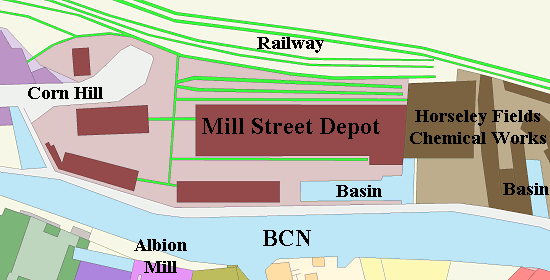
The location of the depot.
The depot operated in the London and North
Western Railway's usual efficient manner. Work at the depot was
extremely methodical just like in a modern Royal
Mail sorting office. Packages of all shapes and
sizes arrived from all over the country, and every
one had to be accurately sorted and sent to the
correct destination. Similarly parcels and all kinds
of manufactured goods that were sent by rail from
Wolverhampton had to be accurately sorted and
dispatched on the correct train.The London and
North Western Railway buildings are of the company's
usual pattern, and were designed at Crewe. All of
the components including the bricks were produced at
Crewe and would have been delivered to Wolverhampton
as a kind of kit, just like buying a garden shed
today from a D.I.Y. store.
Inside there would have been platforms fitted
with standard types of “North Western” cranes and
hydraulic lifts, some of which could lift loads of
up to 14 tons. There would have been warehouse
facilities for the temporary storage of inwards and
outwards goods, and provisions for the storage of
perishable items such as food. |
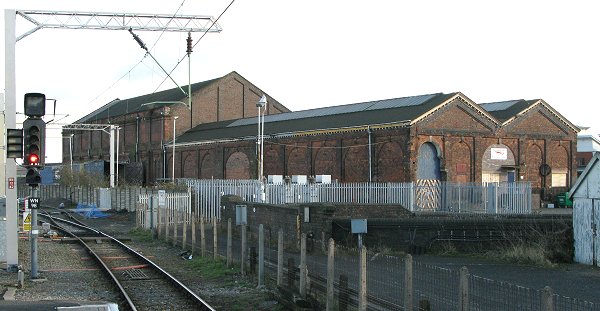
Mill Street Goods Depot as it is today,
showing the mixture of S& B and L.N.W.R. buildings.
| The L.N.W.R. moved vast amounts of goods, many of
which were for the railway’s own use. Being the
largest railway company in the country it used an
enormous amount of consumables which all had to be
transported around the network. In 1913 no less than
57.5 million tons of freight were transported
throughout the system.
In the early years of the 20th century Mill Street
Goods Depot was handling around 50,000 tons of goods
annually. Wolverhampton became the headquarters of the L.N.W.R.
South Staffordshire and East Worcestershire Goods
District, with offices in the Queens Building. Goods
traffic greatly increased with the building of many
private sidings. In 1887 Thomas Mitchelhill became
District Goods Manager. |
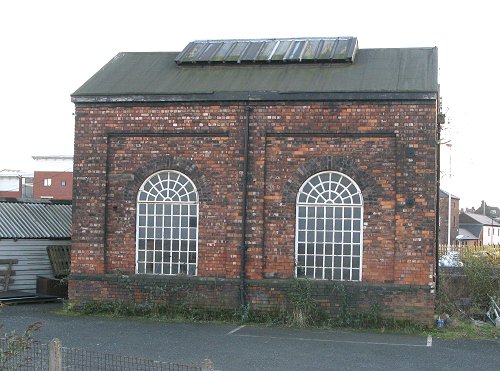
The hydraulic engine house that is on the
opposite side of Corn Hill to the depot. This produced the
pressurised hydraulic fluid for the cranes and lifts that was
piped into the depot via Corn Hill bridge. |
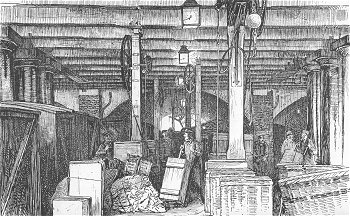
| A contemporary
drawing showing goods being unloaded from an L.N.W.R.
train. |
|
It was as expensive
to transport an empty wagon as one that was full, and
so efficient use of wagon space was essential. Heavy
articles could not be placed on top of fragile ones,
and care had to be taken to avoid spillage or
contamination from one package to another.
Some
articles were moved at the owner’s risk whereas
others were moved at the company’s risk, and so
errors could be costly. |
| Wagons were loaded and unloaded by gangs of men
consisting of porters, loaders, checkers, yardsmen
and warehousemen. A typical gang consisted of five
men, but this varied with fluctuating levels of
traffic. Gangs worked a 72 hour week, which included
12 hours for meal breaks. Sometimes alternate day
and night shifts were required and salaries were
boosted by a bonus system based on the weight of
goods moved during each shift. |
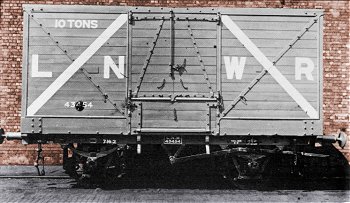
An L.N.W.R. 10 ton goods van. |
|
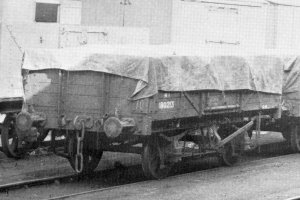
A loaded and sheeted L.M.S. wagon. |
There were many special wagons for delivering
different types of goods. Initially wagons were open
topped with either high or low sides. One of the
most profitable commodities that railways delivered
was coal. This was mined in huge quantities, and in
the days of poor roads and primitive vehicles, the
only efficient and cheap way of delivery was by
rail, and coal wagons were developed for the
purpose. There were mineral wagons, coke wagons,
low-sided open wagons, and eventually covered goods
vans. |
| Specialised vans were developed for transporting
such things as cattle and butter, refrigerated vans
held frozen food, fish or meat. Some fruit vans
were fitted with steam heaters to help ripen
bananas. Arriving wagons were transported to the
loading platform or the yard in readiness for the
transfer of their contents to road vehicles for the
final part of the journey. The platform was
accessible by an open arch, so that when necessary,
road vehicles could be backed up to it and easily
loaded. Invoices for the incoming goods were
collected and inspected. Each included a description
of the goods, their destination, weight and
particulars of the charges. These were passed to the
delivery office where details were entered into a
book and stamped with an identity number. The
arrival time was noted and the charges were checked.
The Marking Clerk then entered the details of where
the item would be stacked on the platform or sorting
bank, in readiness for collection. |
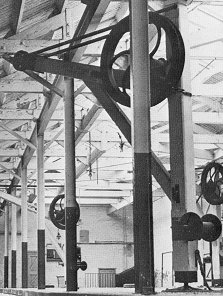
A typical L.N.W.R. crane. |
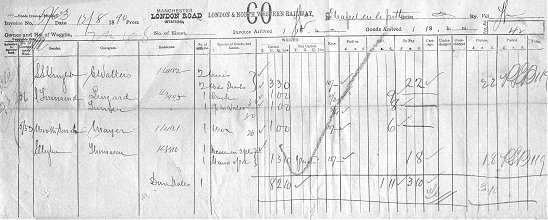 |
| An L.N.W.R. goods
invoice issued at Manchester London Road Station. It is
dated 13th August 1890 and is for buckets, shovels, a
box and a stand. It includes details of the goods, their
weight and the charges including payment for the
porters. |
|
| Each platform was divided into sections that were
marked by letters and numbers painted on the roof
supporting columns, along its length.
The invoice was
then passed on to a clerk who produced a delivery
sheet for the driver of the road vehicle. |
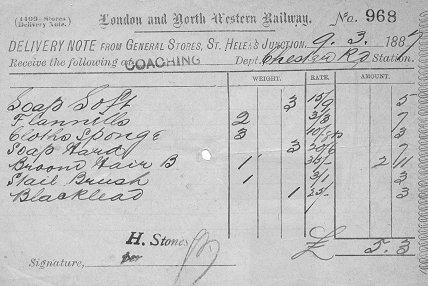 |
| A delivery note
issued by the General Stores at St. Helens Junction on
9th March 1887 for soap, flannels, sponges, brushes and
black lead. |
|
| When the paperwork was complete the invoice was
returned to the platform where a gang of men would
unload the wagons and position the goods at
appropriate places on the platform, using hand trucks
and sack trucks. There was also space for goods that
had arrived without an invoice, which sometimes
arrived late due to delays with the paperwork. If
the unloaded goods were to be left for any length of
time on the platform a warehouseman might be on hand
to prevent pilfering. |
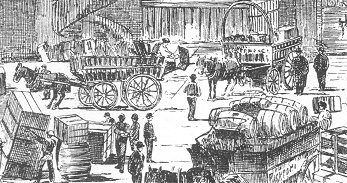
A typical "North Western" goods yard; a
veritable hive of activity. |
The loading of the goods onto road
vehicles for the final part of the journey was in
the hands of the Delivery Foreman, who examined the
paperwork and organised the porters during the
operation.
In the early days the road vehicles would have
consisted of a horse and cart that was driven by a
cartage man, known locally as a carter, carman,
drayman or lorryman. |
|
They were slowly replaced by lorries, which were
handsomely painted in the company’s livery; horses
however continued in use for many years.
After emptying, the wagons were transferred to
another platform in readiness to receive outward
going goods, which arrived on loaded road vehicles.
These vehicles were stopped at the weighbridge
office, and the consignment notes were stamped with
an official stamp for authenticity. |
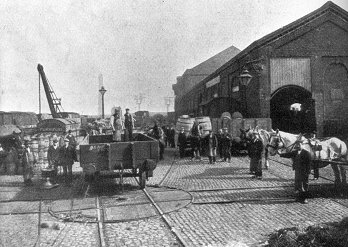
| Mill
Street Depot yard in 1908. In the foreground is a wagon
turntable, several of which were in the yard. |
|
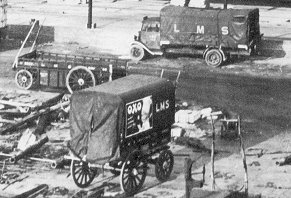
| Some of the road
vehicles that were used in L.M.S. days. |
|
After inspection they backed-up to the outward goods
platform. The Unloading Foreman then inspected the
consignment notes and handed them to the checkers
and unloading gangs, who unloaded the goods onto the
platform, and checked them against the entries on the
notes.
Finally the goods were weighed and placed in
appropriate positions on the platform, corresponding
to their final destination. |
| The empty wagons were filled by a loading gang,
consisting of a checker, a loader, a caller-off and
several porters. When loaded they were sheeted,
labelled and taken to a siding to await their
locomotive. The consignment notes were taken to the
shipping office where the clerks recorded the
details, and made out the invoices that were handed
to the brakeman who was in charge of the outgoing
train. If they were not ready in time for the
departing goods train, they were sent by fast
passenger train to their destination. |
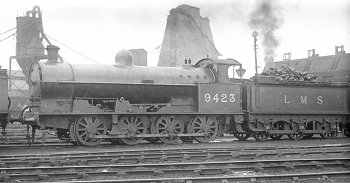
An L.N.W.R. "G2" class goods locomotive at
Willesden Shed. These were a common sight throughout the network
and many continued in use until almost the end of steam. |
| On 1st January, 1923 the London & North Western
Railway became part of the London Midland and
Scottish Railway, known as the L.M.S. which
continued to run the goods depot until the railways
were nationalised on 1st January, 1948. From 1959
the goods depot was run from Birmingham as a result of the
introduction of the Midland Freight Traffic Plan. |
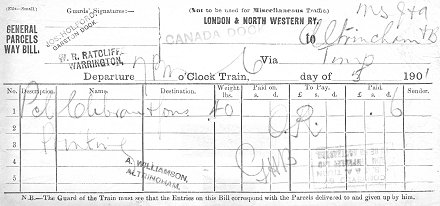
An L.N.W.R. Way Bill issued at Canada Dock.
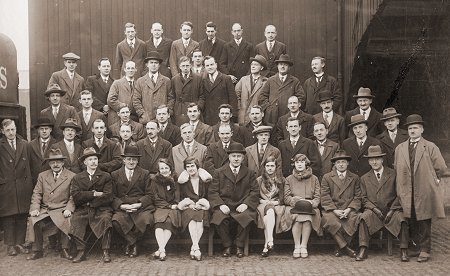
Some of the L.M.S. goods staff in the early 1930s.
Back row L to R: ?,?,
Harry Newman, ?,?,?
Next row L to R: ?,?, Powell, ?, Jimmy Cuthbertson, Dunton, ?, Bob Clayton, ?
Next row L to R: ?, Harry Ubbotson, ?, Joe Edwards, D.
Pinney, ?,?, Perks, Burton, Mantle
Next row L to R: ?, Harry Johnson, ?, Fred Humphreys, ?,?,
Perrins, Jack Mason, ?,?,?,?, Thomas
Front row L to R: ?,?,?,?,?,?,?, Edith Ubbotson, ?,?,?
This has been a brief description of the goods
depot, and the daily procedures that were rigidly
adhered-to, so as to ensure that all of the goods
were transported to their correct destination in the
most efficient manner. As time progressed road
transport slowly took over and the quantity of goods
transported by rail fell dramatically.
There was a
time when nearly every railway station had its own
goods depot. Some were large and others small, but
they played an important role in earning revenue for
the railway company. Most of the old goods depots
are now long-gone, and we are lucky to still have
such an excellent example standing in Wolverhampton,
and still in use today.
If anyone has an further information on the goods depot or
can name anyone on the staff photograph please
send me an email.

|
Return to the
previous page |
|
|

